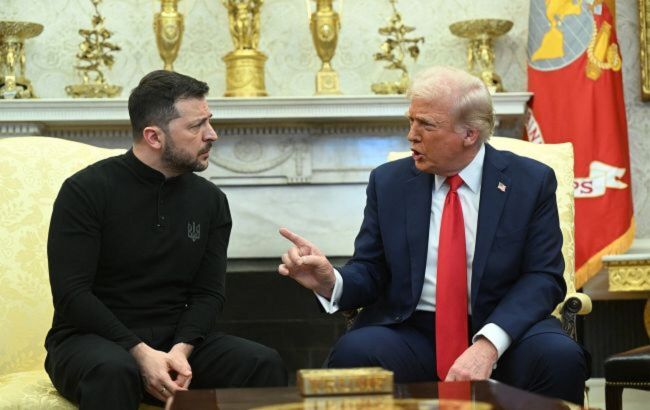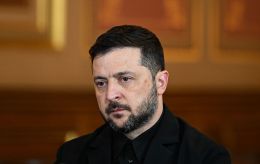Trump's 'final offer' - Axios reveals peace plan for Ukraine and Russia
 Photo: Volodymyr Zelenskyy and Donald Trump (Getty Images)
Photo: Volodymyr Zelenskyy and Donald Trump (Getty Images)
The US is awaiting Kyiv’s response to the peace framework outlined in American President Donald Trump’s "final offer." The plan reportedly includes a freeze of the front line, security guarantees for Ukraine, US "recognition" of Crimea as part of Russia, the lifting of sanctions, and more, according to Axios.
Sources directly familiar with the proposal told the American outlet that the US expects a response from the Ukrainian side to this peace plan as early as April 23.
Western media also report that the one-page document, which the US presented to Ukrainian officials in Paris last week, outlines such terms as Trump’s "final offer."
The White House insists it is ready to walk away from peace initiatives if the parties do not reach an agreement soon.
According to Axios, the proposal would require serious concessions from Ukrainian President Volodymyr Zelenskyy, who has previously ruled out accepting Russia’s occupation of Crimea and parts of four eastern regions.
Although Vladimir Putin reportedly proposed freezing the current front line to reach a deal, he previously rejected other elements of the American plan, such as the deployment of European peacekeepers on Ukrainian territory, Western media note.
An Axios source close to the Ukrainian government said Kyiv views the proposal as heavily biased in favor of Russia.
"The proposal says very clearly what tangible gains Russia gets, but only vaguely and generally says what Ukraine is going to get."
What Russia could gain under Trump's proposal:
-
De jure US recognition of Russia’s control over Crimea;
-
De facto recognition of Russia’s occupation of parts of Luhansk, Donetsk, Kherson, and Zaporizhzhia regions;
-
A pledge that Ukraine will not join NATO (though the document says Ukraine may join the European Union);
-
Lifting of US sanctions against Russia, imposed since 2014;
-
Expanded economic cooperation with the US, particularly in energy and industry.
What Trump's proposal offers Ukraine:
-
"Reliable security guarantees" involving a special group of European countries and potentially non-European like-minded states (the document is vague on how the peacekeeping operation would function and does not mention US participation, Axios notes);
-
The return of a small portion of the Kharkiv region currently occupied by Russian forces;
-
Unrestricted navigation along the Dnipro River, which runs along the front line in southern Ukraine;
-
Compensation and assistance for reconstruction, though the document does not specify the source of funding.
Other elements - Zaporizhzhia NPP and mineral rights
The Zaporizhzhia Nuclear Power Plant, currently occupied by Russian troops, would be considered Ukrainian but operated by the US. Electricity from the plant would be supplied to both Ukraine and Russia, according to Axios.
The document also mentions a US-Ukraine agreement on the minerals deal, which Trump says is to be signed on Thursday.
Plan development
Axios also reports that the plan was developed after Trump’s envoy Steve Witkoff met with Putin for more than four hours last week.
After the proposal was presented, the Russian dictator allegedly offered to pause the invasion along the current front line as part of a potential agreement, the Financial Times wrote.
This is supposedly "the biggest gesture" from Putin, signaling his willingness to strike a peace deal, but European officials remain skeptical, according to Western media.
Kellogg to London, Witkoff to Moscow
Witkoff is expected to travel to Moscow this week for his fourth meeting with Putin, the White House announced on April 22.
It is also expected that Witkoff and US Secretary of State Marco Rubio will skip the negotiations in London on Wednesday, April 23, involving officials from the US, Ukraine, France, Germany, and the UK. Both had previously planned to attend. Instead, the US delegation will reportedly be led by Ambassador Keith Kellogg.
The US proposal is expected to be part of the talks, Axios reports.
Ukrainian delegation prefers to first discuss ceasefire
The US official involved in the talks said Rubio and Witkoff worked together to "to develop a framework to get us closer to reaching an end to the war."
However, US media report that over the past 24 hours, Ukraine has shown signs it prefers to discuss a 30-day ceasefire during Wednesday’s meetings in London, rather than Trump’s peace framework.
"The decision was made for the secretary to not travel to London. Instead, the US delegation will continue to engage in conversations with UK and Ukrainian counterparts," the official said.
Rubio wrote on Twitter that he had a “productive” conversation with his British counterpart and looked forward to “following up” after the discussions in London.
White House press secretary Karoline Leavitt told reporters Tuesday that “talks are ongoing, and hopefully we’re moving in the right direction.”
Notably, during a press conference yesterday, Ukrainian President Volodymyr Zelenskyy stated the country is ready for an unconditional ceasefire, but that this depends on Putin’s willingness.
Zelenskyy also commented on various media publications concerning potential peace deal terms and concessions. He emphasized that any discussions on Crimea, ZNPP, and NATO are speculative, as an unconditional ceasefire is the first necessary step before any substantive Ukraine-Russia talks can begin.
Check out a separate piece on Trump’s final push and whether the US is close to a peace deal for Ukraine, and what Putin might be planning.

